Our son Ben, who paddles with us when he's in town, found a kayak reference on the website for the comic XKCD -- terrific!
Check out the original comic here. Be sure to mouse over the image to see the hidden caption!
Tuesday, August 27, 2013
Sunday, August 25, 2013
Just Passing Through
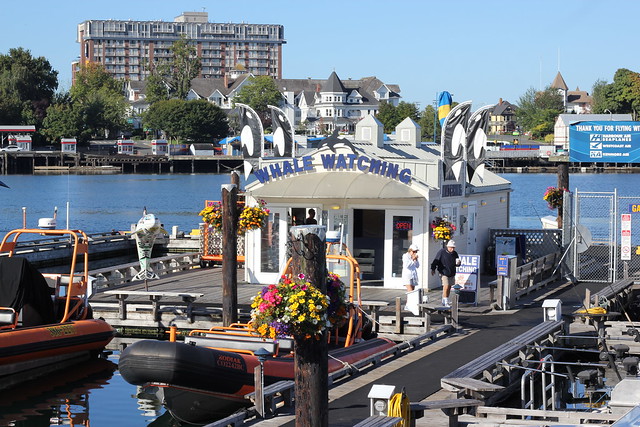
They don't call it Sunday for nothing, you know. And a gorgeous Sunday it was as Louise and I headed down to Great Pacific Adventures for a morning of whale watching.
While some folks went out in a zippy sport model....

...we were out in the King Salmon, a 45-foot ocean cruiser.
The last couple of times we've been out whale watching we headed out of Victoria into American waters towards the south-south east, finding J-Pod of the local southern resident orcas in the San Juan Islands. Today, the residents were spotted far to the north near Active Pass, about as far away as the local whale watching companies can travel and return in time for their next run. The question was were the killer whales going to hang around long enough for us to get there? For a while it looked like all I was to get were pictures of ferries...

...especially when we turned around before we got to Active Pass. I assumed we turned around because we just weren't going to make it before the whales moved on, but it turned out a small group of transient killer whales had been spotted along the south shore of South Pender Island as they made there way along the west coast of the continent. Since that was on the way back, we'd have more time on site than if we continued after the resident pod. And a good choice it was as soon we saw them slowly meandering up the channel.


It looks like Homeland Security runs whale watching trips on the side. Who knew?
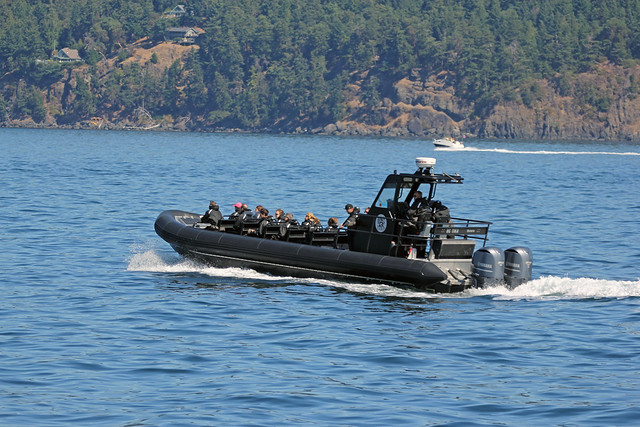
The naturalist guide aboard our vessel thought there were five or six travelling together, although the most I could see at one time was four, but one of them was clearly a juvenile.
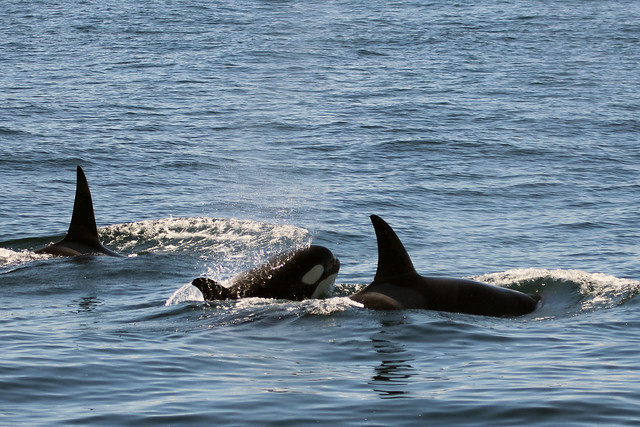
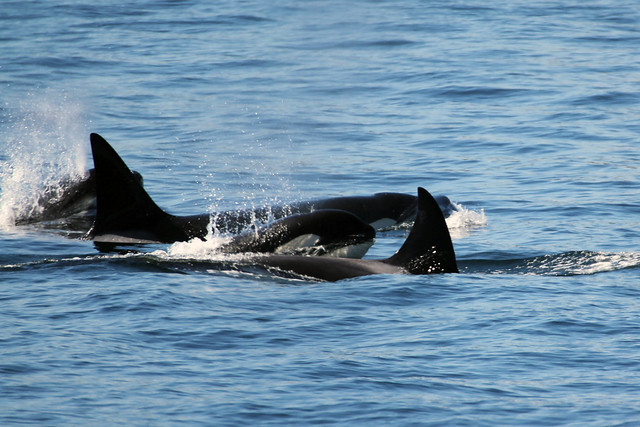
And soon they were off, and so were we.
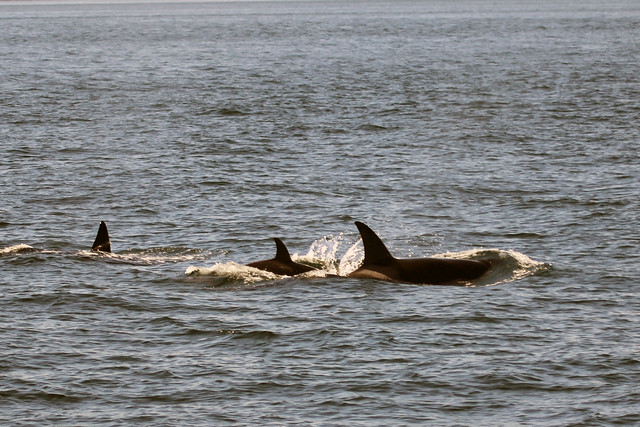
How close is too close when you encounter whales?
 Fisheries and Environment Canada recommend that vessels (and that includes kayaks) should stay a minimum 100 metres away from whales. Don't approach from in front or behind, only from the sides.
Fisheries and Environment Canada recommend that vessels (and that includes kayaks) should stay a minimum 100 metres away from whales. Don't approach from in front or behind, only from the sides.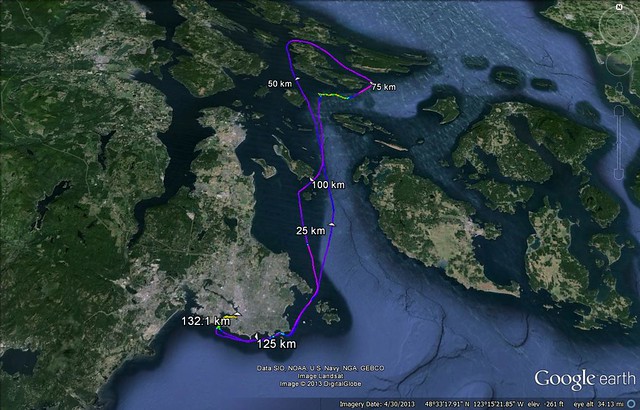
More pictures are here.
And embedded below is a bonus video. While we ended up watching the transients, here's a video of what the southern residents were doing in Active Pass (via bcpolak on youtube). It turns out that all three southern resident pods had formed a superpod. About 80 orcas swam through the pass at once!
Wednesday, August 21, 2013
One That Works
Usually I post silly videos of kayakers when things go wrong, but here's one when a kayaker tries something silly and it goes right!
Check out this quick video from the Sea Kayaking Kefalonia Facebook page:
Check out this quick video from the Sea Kayaking Kefalonia Facebook page:
Thursday, August 15, 2013
Because They Klingon...?
Maybe Captain Picard should ask the Enterprise's leading kayaking expert, Chief Miles O'Brien. After moving on to Deep Space Nine, he liked to relax by whitewater kayaking in Quark's holosuites. He dislocated his shoulder a number of times and Quark eventually told him that the kayaking program had "gone missing" to prevent further injuries. I guess no more paddling where no one has paddled before for him.
(Picard meme pic from Level Six's Facebook page; O'Brien photo and info from Memory Alpha.)
River Otters in the News!
We often see river otters (now called Lontra canadensis, but previously Lutra canadensis) along the seashore when we're out kayaking. Otters are in Beaver and Elk Lake, and Thetis Lake too, but it's easiest to find them in Cadboro Bay where the rocky side of the bay is a fine place for otters to get plenty of things to eat or climb ashore to find good places to sleep. Seeing otters in their quick nimble movements -- wow, that's one of the nicest things about paddling!
It can be hard to remind ourselves not to get too close to them. The Department of Fisheries and Oceans protocol for otters is the same as for other marine mammals like seals and whales: don't approach them any closer than 100 yards, and get out of their path when you see them on the move. When a human approaches a marine mammal, the animal can be upset and stop feeding, or it can spend a lot of energy getting away from the human and eventually back to its fellows. This is especially a problem for mother animals with babies. When you see on our blog John's photos of river otters or seals that look like we're close enough to pet them like a cat, our boats are nowhere near that close. John has a terrific lens on one of his cameras, and he's gotten really good at using it.
It would be nice to pet a river otter like a cat -- well, it looks like it would be nice! Smooth fur that's thick like mink, limber body, cunning paws... they look sleek and beautiful. But an otter is not a little housecat. For one thing, it's bigger, up to 14 kg. For another thing, it's a 14 kg weasel, not a sweet-tempered neutered tabby housecat! As cheerful as an otter looks sliding and playing, it's not a domesticated animal like a cat or dog -- biting is one of the proper things for an otter to do to survive among big smelly dangerous things, like humans. If you really want to pet an otter, go to the Nature Centre at Beaver Lake and get a good look at the otter that's been stuffed and mounted in a natural pose.
And if you need to know what an otter bite feels like, try reading this article on the CBC's website about a woman who was swimming near an otter in a lake this summer. Ow!
It can be hard to remind ourselves not to get too close to them. The Department of Fisheries and Oceans protocol for otters is the same as for other marine mammals like seals and whales: don't approach them any closer than 100 yards, and get out of their path when you see them on the move. When a human approaches a marine mammal, the animal can be upset and stop feeding, or it can spend a lot of energy getting away from the human and eventually back to its fellows. This is especially a problem for mother animals with babies. When you see on our blog John's photos of river otters or seals that look like we're close enough to pet them like a cat, our boats are nowhere near that close. John has a terrific lens on one of his cameras, and he's gotten really good at using it.
It would be nice to pet a river otter like a cat -- well, it looks like it would be nice! Smooth fur that's thick like mink, limber body, cunning paws... they look sleek and beautiful. But an otter is not a little housecat. For one thing, it's bigger, up to 14 kg. For another thing, it's a 14 kg weasel, not a sweet-tempered neutered tabby housecat! As cheerful as an otter looks sliding and playing, it's not a domesticated animal like a cat or dog -- biting is one of the proper things for an otter to do to survive among big smelly dangerous things, like humans. If you really want to pet an otter, go to the Nature Centre at Beaver Lake and get a good look at the otter that's been stuffed and mounted in a natural pose.
And if you need to know what an otter bite feels like, try reading this article on the CBC's website about a woman who was swimming near an otter in a lake this summer. Ow!
Wednesday, August 14, 2013
International Town Hall Meeting
The Georgia Strait Alliance is hosting an international town hall meeting taking place simultaneously on both sides of the strait next week. Wednesday, August 21 at noon, be on the beach at Arbutus Cove in the suburban Saanich neighbourhood of Victoria BC -- or over on the American side if that's closer to home. The agenda is a public discussion of the proposed route for oil tankers to carry oil from the proposed expansion of the Kinder Morgan pipeline.
The issue of oil tankers in our home waters is an important one for kayakers and other small boat users -- get information to make yourself informed.
I'll correct the GSA note below with the information that Arbutus Cove is accessed by Arbutus Cove Lane off Gordon Head Road or by a footpath off Arbutus Road near its intersection with Gordon Head Road. There is a small sign at the top of the steep footpath and stairs. The closest BC Transit bus route is #12 and both the #27 and the #11 get you a few blocks from the beach access. Wear shoes you can walk in, and bring a jacket even if the day is warm, as Arbutus Cove can be cool even on a hot day. The nearest public restroom and drinking water would be at the University of Victoria or at Cadboro Bay Road and Sinclair Road.
From the GSA website http://wildernesscommittee.org/latest, we quote:
Cross-border Town Hall Meeting: Could the Salish Sea Become a Climate Change Highway?
August 21, 12 noon, Greater Victoria
Arbutus Cove Park, Arbutus Cove Lane, Saanich (off Gordon Head Road on the 12, 13, + 27 BC Transit routes)
Join us for an international town hall meeting, taking place simultaneously on either side of the Kinder Morgan tar sands tanker route through the Salish Sea near Victoria, BC and on San Juan Island, WA.
Kinder Morgan’s plan to build a new tar sands pipeline to the coast and proposals to increase coal shipments from ports on the Lower Mainland and the US could turn the Salish Sea into a major corridor for fossil fuel exports. A massive increase in tanker and coal ship traffic would drastically raise the threat of a catastrophic oil spill that would devastate the marine environment, coastal communities, and the regional economy. The ocean, the marine life it supports, and our shared atmosphere that are all threatened by these proposals don’t recognize the Canada-US border. In our opposition to these shortsighted, climate-changing projects and our advocacy for a better, cleaner future, we must also treat the Salish Sea as a single region, and that means organizing across jurisdictional boundaries.
Join us on August 21 to learn more about fossil fuel export proposals that will affect the Salish Sea, what’s happening on both sides of the border to protect this region, and how you can get involved.
Presented by Wilderness Committee, Georgia Strait Alliance and (in the US) Friends of the San Juans.
Contact for more info: torrance@wildernesscommittee.org / 250-516-9900
The issue of oil tankers in our home waters is an important one for kayakers and other small boat users -- get information to make yourself informed.
I'll correct the GSA note below with the information that Arbutus Cove is accessed by Arbutus Cove Lane off Gordon Head Road or by a footpath off Arbutus Road near its intersection with Gordon Head Road. There is a small sign at the top of the steep footpath and stairs. The closest BC Transit bus route is #12 and both the #27 and the #11 get you a few blocks from the beach access. Wear shoes you can walk in, and bring a jacket even if the day is warm, as Arbutus Cove can be cool even on a hot day. The nearest public restroom and drinking water would be at the University of Victoria or at Cadboro Bay Road and Sinclair Road.
From the GSA website http://wildernesscommittee.org/latest, we quote:
Cross-border Town Hall Meeting: Could the Salish Sea Become a Climate Change Highway?
August 21, 12 noon, Greater Victoria
Arbutus Cove Park, Arbutus Cove Lane, Saanich (off Gordon Head Road on the 12, 13, + 27 BC Transit routes)
Join us for an international town hall meeting, taking place simultaneously on either side of the Kinder Morgan tar sands tanker route through the Salish Sea near Victoria, BC and on San Juan Island, WA.
Kinder Morgan’s plan to build a new tar sands pipeline to the coast and proposals to increase coal shipments from ports on the Lower Mainland and the US could turn the Salish Sea into a major corridor for fossil fuel exports. A massive increase in tanker and coal ship traffic would drastically raise the threat of a catastrophic oil spill that would devastate the marine environment, coastal communities, and the regional economy. The ocean, the marine life it supports, and our shared atmosphere that are all threatened by these proposals don’t recognize the Canada-US border. In our opposition to these shortsighted, climate-changing projects and our advocacy for a better, cleaner future, we must also treat the Salish Sea as a single region, and that means organizing across jurisdictional boundaries.
Join us on August 21 to learn more about fossil fuel export proposals that will affect the Salish Sea, what’s happening on both sides of the border to protect this region, and how you can get involved.
Presented by Wilderness Committee, Georgia Strait Alliance and (in the US) Friends of the San Juans.
Contact for more info: torrance@wildernesscommittee.org / 250-516-9900
Tuesday, August 13, 2013
Taking Kayaking to the Next Level
Trip Deacon is taking kayaking to the next level -- by removing the kayak. Check out the video embedded below:
This showed up in my Facebook feed from at least six different people today, and is a terrifically funny little film. Wish I'd thought of it! Can't wait to see Trip's next adventure!
This showed up in my Facebook feed from at least six different people today, and is a terrifically funny little film. Wish I'd thought of it! Can't wait to see Trip's next adventure!
Saturday, August 10, 2013
Kayaking in the News
It's not everyday that the CBC has two, count 'em, two kayaking stories on its web site, but today is our lucky day.
First, Diane Heche, a 57-year old woman from Yellowknife, has had to end her solo kayak expedition from Tuktoyaktuk, N.W.T., to Gjoa Haven, Nunavut. She began her trek in mid-June, but her kayak became damaged after paddling through bad weather and snow, and she ended her paddle in Paulatuk, about halfway through her planned journey. You can listen to an interview with Diane about the end of her trip here.
In other news, the CBC reports that about a dozen kayakers racing in the Chaudière-Appalache region near Frotenac Park in Québec were rescued this morning after gusts of wind capsized their boats while taking part in a competition. Some kayakers were able to make it to shore, while others had to be rescued by helicopter. No major injuries were reported, but some of the kayakers were treated for hypothermia.
First, Diane Heche, a 57-year old woman from Yellowknife, has had to end her solo kayak expedition from Tuktoyaktuk, N.W.T., to Gjoa Haven, Nunavut. She began her trek in mid-June, but her kayak became damaged after paddling through bad weather and snow, and she ended her paddle in Paulatuk, about halfway through her planned journey. You can listen to an interview with Diane about the end of her trip here.
In other news, the CBC reports that about a dozen kayakers racing in the Chaudière-Appalache region near Frotenac Park in Québec were rescued this morning after gusts of wind capsized their boats while taking part in a competition. Some kayakers were able to make it to shore, while others had to be rescued by helicopter. No major injuries were reported, but some of the kayakers were treated for hypothermia.
Thursday, August 08, 2013
Searching for the Finmen
Norman Rogers was training in his kayak for an upcoming race several years ago when he started feeling unwell. When he finally reached shore, he was barely able to get himself out of the water, and subsequent tests and treatment meant that he would be reducing his paddling time for an extended period. While on his journey to discover the source of his weakness, he wanted to do something to keep his mind on kayaking, and he decided to investigate another journey, the story of the Aberdeen Paddler, an Inuk paddling a traditional Greenland kayak found on a beach near Aberdeen in the early 1700s. Who was this kayaker? Where did he come from? Could someone really have paddled from Greenland to Scotland in a (literally) skin-on-frame kayak?
Rogers' research journey takes him down many paths. From anthropology and archaeology as he explores the history of both the various northern First Nation peoples and their native watercraft, to physics and wave mechanics as he investigates whether such a crossing was even possible. There's even a brief detour into movie review territory, and Rogers' own story of his recovery from surgery to correct a heart defect.
An informative and entertaining read, especially if you're interested in the history of kayaks and their creators. (And check out Simon Willis' interview with the author at Sea Kayak Podcasts.)
Rogers' research journey takes him down many paths. From anthropology and archaeology as he explores the history of both the various northern First Nation peoples and their native watercraft, to physics and wave mechanics as he investigates whether such a crossing was even possible. There's even a brief detour into movie review territory, and Rogers' own story of his recovery from surgery to correct a heart defect.
An informative and entertaining read, especially if you're interested in the history of kayaks and their creators. (And check out Simon Willis' interview with the author at Sea Kayak Podcasts.)
Tuesday, August 06, 2013
A Family Affair
A sunny Tuesday. Well, it's supposed to be. But there's some fog at our launch point at Cadboro Bay.
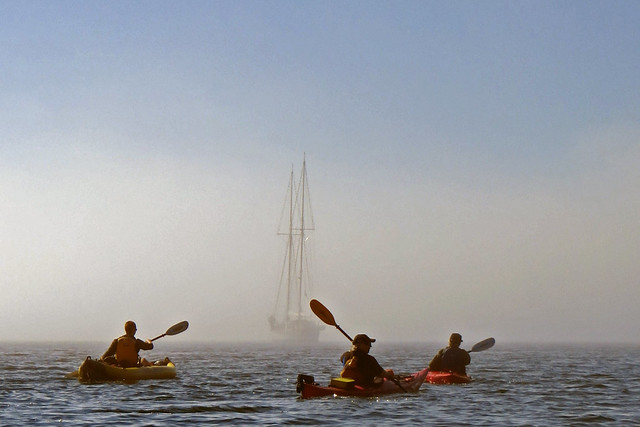
We've got a big group on the water today. Louise and I were joined by my sister Brenda who is hosting my great-nephew Michael who is honeymooning here with his new bride Gwylan. Michael is the grandson of my sister Ann who lived back east but passed away last winter, and he and I have never met. We had a great dinner at Brenda's last night trading stories about Ann, although it was kind of weird hearing one of my sisters referred to as "Grandma."
Thanks to Paula, who also joined us on the water today, we were able to get ourselves as well as Brenda, Michael and Gwylan on the water for a nice gentle paddle from Cadboro Bay to Cattle Point. Paula used her Eliza, and lent us her Pamlico and two inflatables, setting a personal record for having four of her kayaks on the water at once.
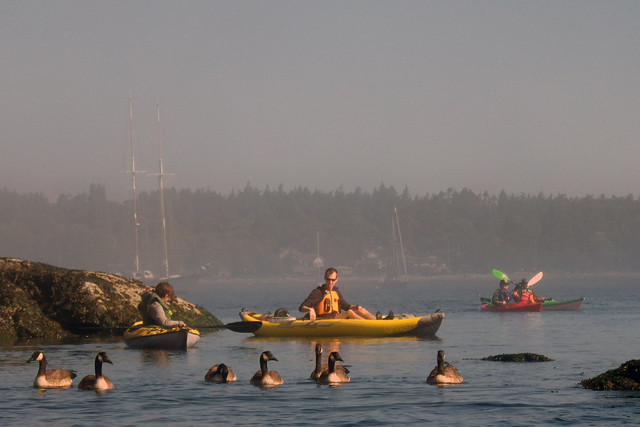
I showed off the amazingly scenic Juan de Fuca Strait!

Okay, you'll have to trust me on that.
The fog came and went and came and went, but eventually went. The geese didn't care one way or the other.

Apart from the geese, we didn't see much in the way of wildlife at first, something we've noticed on other foggy days. Sometimes I think all the animals just sleep in on foggy days. Can't say I blame them.

Eventually we did see a few seals tanning on a rock...
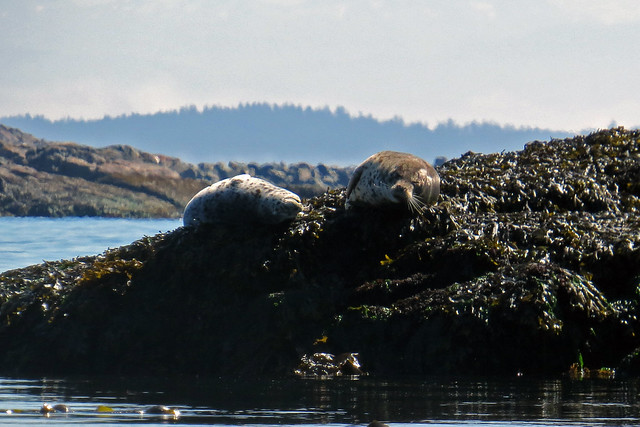
...and after a quick crossing to Flower Island...

...we saw a few more.
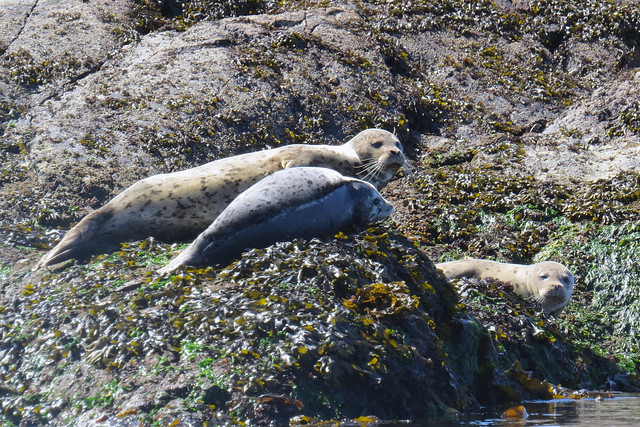
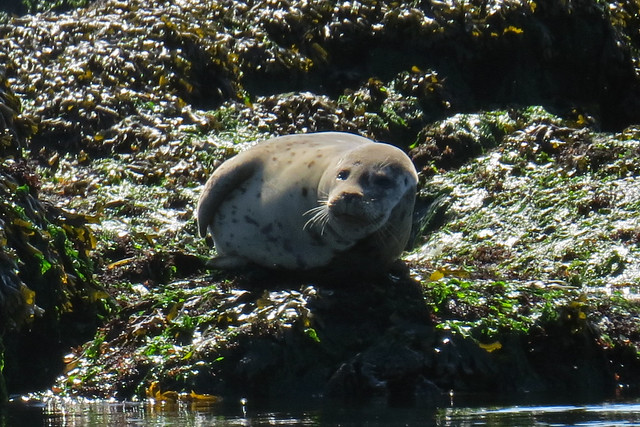
Awesome day on the water with awesome people -- that's how you spend a Tuesday!
Trip length: 6.20 km
YTD: 41.66 km
More pictures are here.
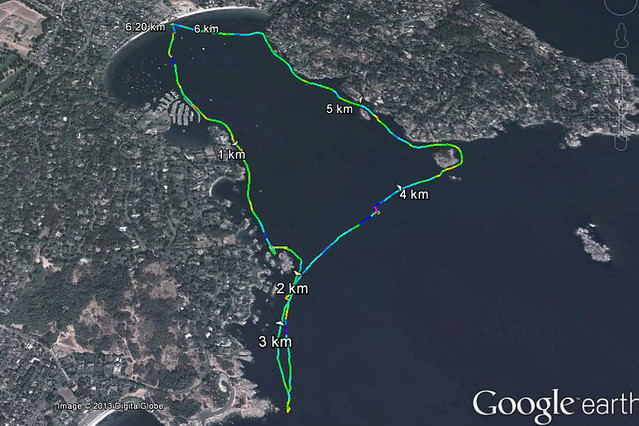

We've got a big group on the water today. Louise and I were joined by my sister Brenda who is hosting my great-nephew Michael who is honeymooning here with his new bride Gwylan. Michael is the grandson of my sister Ann who lived back east but passed away last winter, and he and I have never met. We had a great dinner at Brenda's last night trading stories about Ann, although it was kind of weird hearing one of my sisters referred to as "Grandma."
Thanks to Paula, who also joined us on the water today, we were able to get ourselves as well as Brenda, Michael and Gwylan on the water for a nice gentle paddle from Cadboro Bay to Cattle Point. Paula used her Eliza, and lent us her Pamlico and two inflatables, setting a personal record for having four of her kayaks on the water at once.

I showed off the amazingly scenic Juan de Fuca Strait!

Okay, you'll have to trust me on that.
The fog came and went and came and went, but eventually went. The geese didn't care one way or the other.

Apart from the geese, we didn't see much in the way of wildlife at first, something we've noticed on other foggy days. Sometimes I think all the animals just sleep in on foggy days. Can't say I blame them.

Eventually we did see a few seals tanning on a rock...

...and after a quick crossing to Flower Island...

...we saw a few more.


Awesome day on the water with awesome people -- that's how you spend a Tuesday!
Trip length: 6.20 km
YTD: 41.66 km
More pictures are here.

Sunday, August 04, 2013
Seal of Disapproval
There's no question that our kayaking mojo has been absent this year. We've just gone through the driest and most sunshiniest month ever recorded in these parts and we only kayaked twice. Part of the problem is we spent the earlier part of the year nursing minor aches and pains, and dealt with some energy-sapping family matters. But those are winding down now, and we're feeling relatively healthy, so we're trying to get back in to the paddling swing again. And although it was overcast when we arrived at Cadboro Bay beach, the weatherman promised that it would burnoff and the sun would out soon.
And the weatherman always keeps his promises, right?

Paula joined Louise and myself and we headed out hoping that the weatherman would indeed keep his promises. And it looked like he just might. As we paddled along the north side of the by, the thin cloud layer began to abate.

This heron was enjoying the morning almost as much as we were.

We reached Flower Island and paddled around the far side of the island where a pair of eagles were resting.
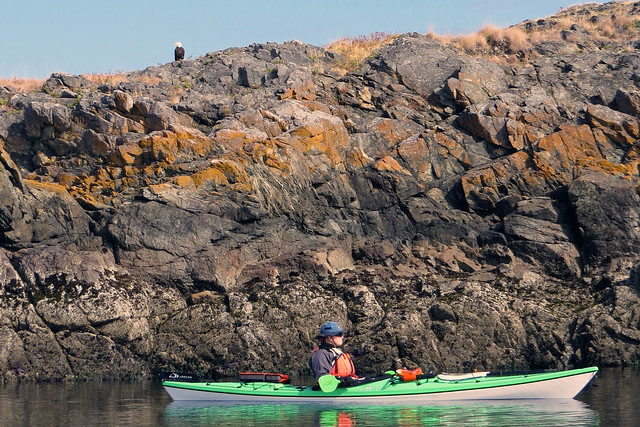
One flew off to sit in a tree....

...while one seemed quite content to sit in the sun.

While I drifted away checking out the eagles, Louise was having a close encounter of her own.
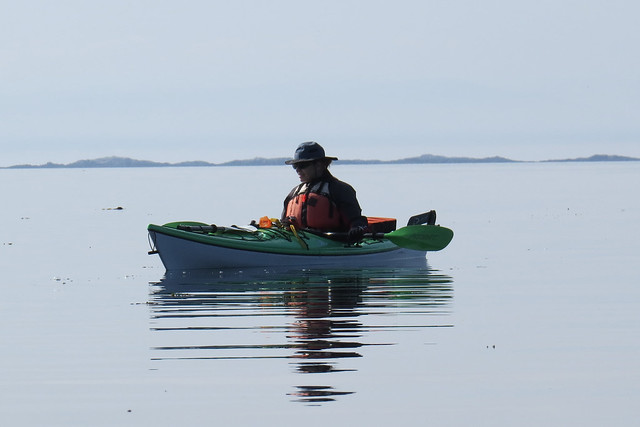
A seal had taken an interest in her and was following close behind her, diving and swimming under her boat.
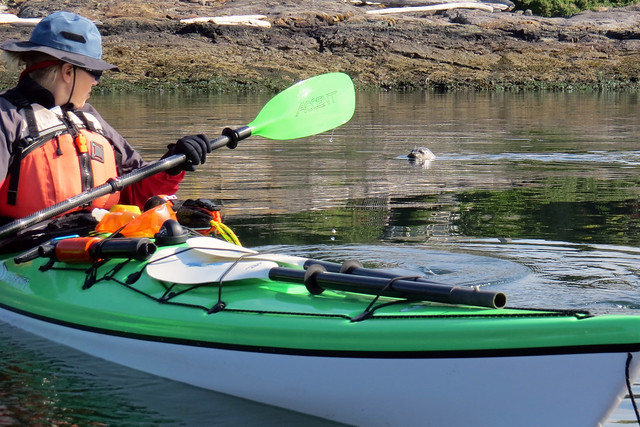
Louise reported that it was swimming up to her, diving, turning upside down and looking up here. She spent a few minutes mesmerized as it swan and performed in the underwater sunlit rays.
From Flower, we crossed to Jemmy Jones Island with the intention of paddling around it, but as we closed in, we could hear seals barking and we could see young seals at both ends of the island. We decided to forgo paddling around and leave the young ones in peace.
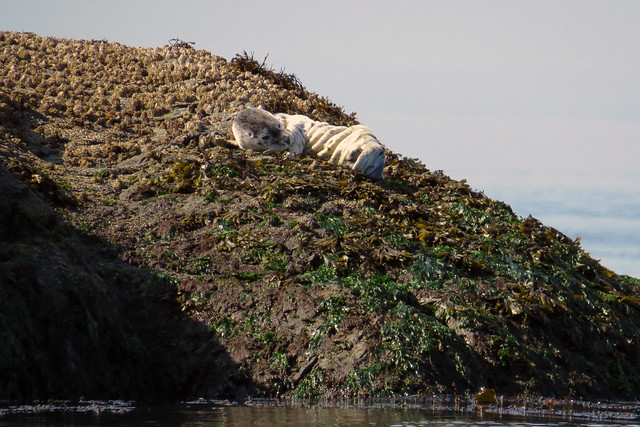
Instead, we paddled towards the end of Ten Mile Point and played around in a cove that only exists at low tide. Normally, this would be a series of small to medium-sized channels, but not today. We spent a few minutes floating around checking out the sponges and seaweed.
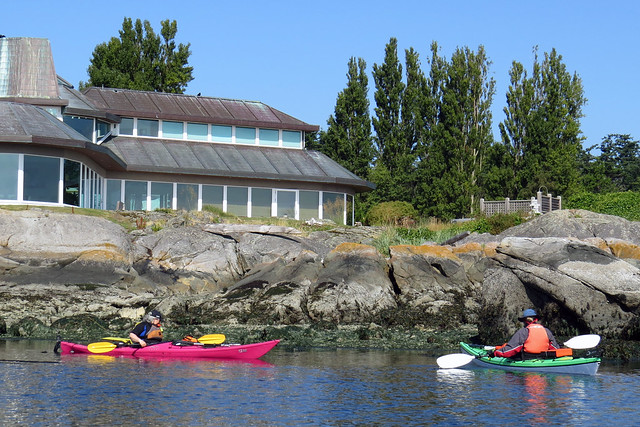
After a while, a mother seal and her baby entered the channel.
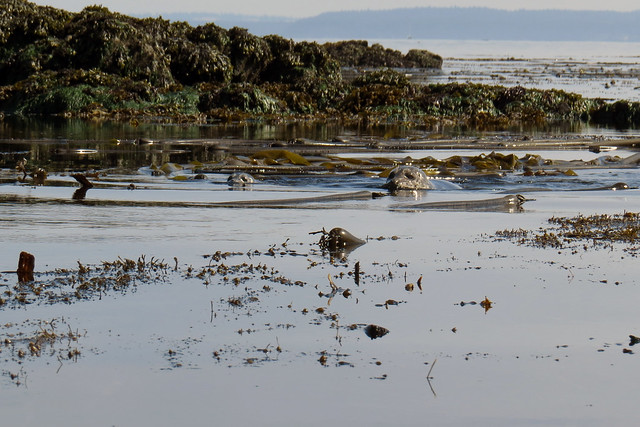
They seemed calm at first, but clearly baby seal was interested in us and kept trying to get closer. Mother seal kept swimming in front of the baby and nudging it away from us.
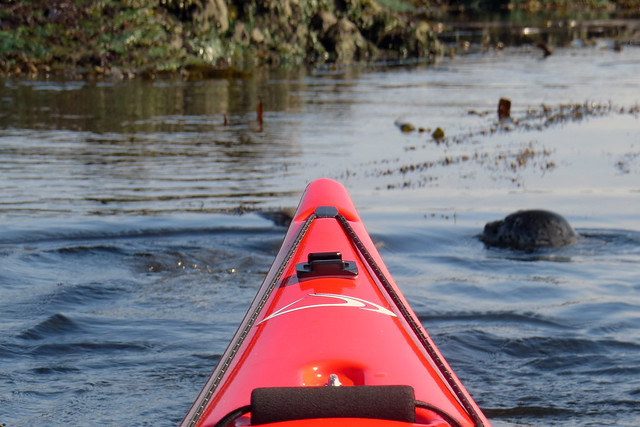
Finally, she popped up right in front of me, and with an exasperated splash let us know that we were no longer welcome.

Even though we were in the cove first, we weren't going to argue the point and quickly moved away.
Afterwards, we discussed whether the seal was being overtly aggressive or not. We concluded that the seals must have been somewhat curious as they had clearly approached us -- made a straight line for me at one point -- but mom had obviously determined that we had overstayed in their area and gave a polite but firm warning.
So we took the hint and headed back, past Flower Island, where the eagle was still in the tree.
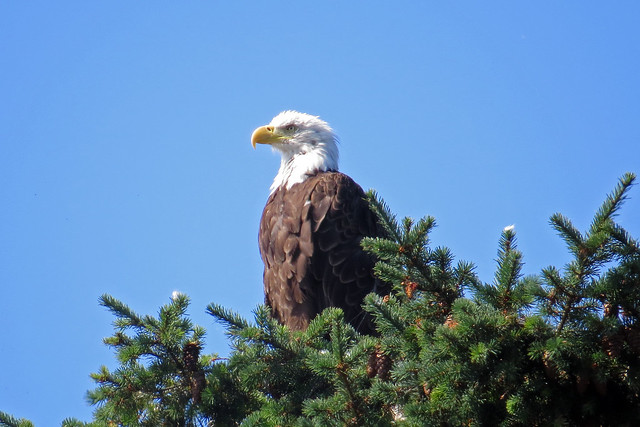
Trip length: 6.43 km
YTD: 35.46 km
More pictures are here.
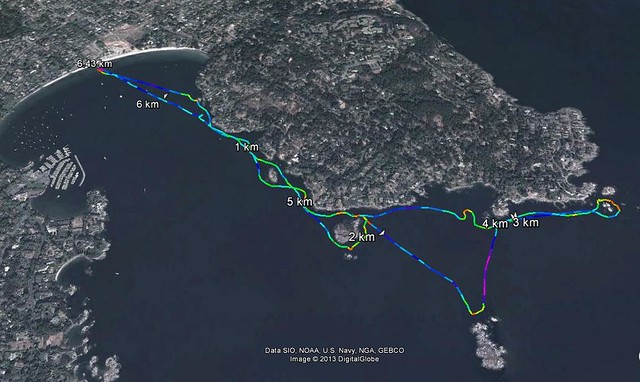
And the weatherman always keeps his promises, right?

Paula joined Louise and myself and we headed out hoping that the weatherman would indeed keep his promises. And it looked like he just might. As we paddled along the north side of the by, the thin cloud layer began to abate.

This heron was enjoying the morning almost as much as we were.

We reached Flower Island and paddled around the far side of the island where a pair of eagles were resting.

One flew off to sit in a tree....

...while one seemed quite content to sit in the sun.

While I drifted away checking out the eagles, Louise was having a close encounter of her own.

A seal had taken an interest in her and was following close behind her, diving and swimming under her boat.

Louise reported that it was swimming up to her, diving, turning upside down and looking up here. She spent a few minutes mesmerized as it swan and performed in the underwater sunlit rays.
From Flower, we crossed to Jemmy Jones Island with the intention of paddling around it, but as we closed in, we could hear seals barking and we could see young seals at both ends of the island. We decided to forgo paddling around and leave the young ones in peace.

Instead, we paddled towards the end of Ten Mile Point and played around in a cove that only exists at low tide. Normally, this would be a series of small to medium-sized channels, but not today. We spent a few minutes floating around checking out the sponges and seaweed.

After a while, a mother seal and her baby entered the channel.

They seemed calm at first, but clearly baby seal was interested in us and kept trying to get closer. Mother seal kept swimming in front of the baby and nudging it away from us.

Finally, she popped up right in front of me, and with an exasperated splash let us know that we were no longer welcome.

Even though we were in the cove first, we weren't going to argue the point and quickly moved away.
Afterwards, we discussed whether the seal was being overtly aggressive or not. We concluded that the seals must have been somewhat curious as they had clearly approached us -- made a straight line for me at one point -- but mom had obviously determined that we had overstayed in their area and gave a polite but firm warning.
So we took the hint and headed back, past Flower Island, where the eagle was still in the tree.

Trip length: 6.43 km
YTD: 35.46 km
More pictures are here.

Labels:
Cadboro Bay,
eagles,
Flower Island,
herons,
seals,
Victoria
Saturday, August 03, 2013
SUP from Cuba to Florida in 28 hours!
Check out the news! Paddler Ben Friberg made it all the way from Cuba to Florida on a 14-foot stand-up paddleboard -- in 28 hours. The Telegraph wrote about his crossing and included a video, and CTV news as well, and the Miami Herald. At least two other people have made similar trips on a surfboard, apparently.
One Conversation
Had a good conversation today while paddling in Telegraph Bay. Well, while walking there with Bernie, the landlady's dog, and the little inflatable kayak on a luggage roller. And with several other people walking, loafing on the shore, or swimming, as well as dogs, and random birds, and a few small boats on top of cars or floating moored in the bay. It all seemed like one conversation, even after we got to the bay and Bernie and the dog took off down the shingle, heading for the rocks.
The family with a little girl chatted with Bernie and their little one turned down a chance to float in a boat. Turns out they had a bigger girl as well, who had scrambled along the shoreline rocks to the little cliff and made her way to the top! Meanwhile, the landlady's dog tugged Bernie across the rocks and the shingle to the other rocks and investigated every piece of bullwhip kelp he could get his teeth into. The shore at Telegraph is steeper than the dog is used to at Cadboro Bay, and so he ended up bobbing over his head a couple of times. It was a cold and shivering dog who tugged Bernie all the way back to the Beach House while I paddled.
There was a photographer with a tripod who took his camera down after a while, but I tried to stay out of his way. He said he didn't mind, but... He probably wanted to photograph wildlife like an otter or a heron, not a brightly-coloured kayak with a small stout woman, but artists have to work with what they have...
There actually was a heron on the right-hand shoreline when I paddled over there. It held still just long enough for me to snap this picture before it spread its pterodactylian wings and croaked something that was either "good-bye" or "take off!"
I had to share the water with a swimmer this time. He walked down to the beach and waded in, wearing a wetsuit and carrying his goggles and swim fins. Looked like fun to me, and I'm guessing to his friend on shore. There was a silent conversation there... or maybe not so silent. I wasn't wearing my new hearing aids (of course!) and anything they muttered would have gone unheard.
Other people came and went, some sitting on the quiet beach the whole while I was there, and others pausing for only a few minutes. One couple sat in the cab of their truck instead of walking to the bench or along the shore.
The dogs were all undilutedly happy with where they were and what they were doing, even if a few of the people didn't look like they were Totally Into Having A Nice Walk On A Warm Day. Go figure. Can't tell what people are thinking just by looking at them, except when they're looking at my kayak. Then they're thinking That is the littlest boat I've ever seen, and it fits right into that bag! Out of their mouths come different things based on their agendas, everything from "Do you have safety equipment? Now, don't you go out getting yourself into trouble way out there!" to "Where can I get one of those?"
My agenda was to go to this quiet little bay with my partner and the goofy dog we look after, to paddle for a little while in this cool peaceful place, and roll my boat home. As I plodded up the slope from the shore, someone else was making his way down with that look on his face that says I'm heading toward the best part of my day!
"We're so lucky to be here," he said.
 |
| Happy dog, happy dog - sploosh! |
The family with a little girl chatted with Bernie and their little one turned down a chance to float in a boat. Turns out they had a bigger girl as well, who had scrambled along the shoreline rocks to the little cliff and made her way to the top! Meanwhile, the landlady's dog tugged Bernie across the rocks and the shingle to the other rocks and investigated every piece of bullwhip kelp he could get his teeth into. The shore at Telegraph is steeper than the dog is used to at Cadboro Bay, and so he ended up bobbing over his head a couple of times. It was a cold and shivering dog who tugged Bernie all the way back to the Beach House while I paddled.
There was a photographer with a tripod who took his camera down after a while, but I tried to stay out of his way. He said he didn't mind, but... He probably wanted to photograph wildlife like an otter or a heron, not a brightly-coloured kayak with a small stout woman, but artists have to work with what they have...
There actually was a heron on the right-hand shoreline when I paddled over there. It held still just long enough for me to snap this picture before it spread its pterodactylian wings and croaked something that was either "good-bye" or "take off!"
I had to share the water with a swimmer this time. He walked down to the beach and waded in, wearing a wetsuit and carrying his goggles and swim fins. Looked like fun to me, and I'm guessing to his friend on shore. There was a silent conversation there... or maybe not so silent. I wasn't wearing my new hearing aids (of course!) and anything they muttered would have gone unheard.
Other people came and went, some sitting on the quiet beach the whole while I was there, and others pausing for only a few minutes. One couple sat in the cab of their truck instead of walking to the bench or along the shore.
 |
| Bernie does actually have a head, even if more of the happy dog shows in this photo. |
The dogs were all undilutedly happy with where they were and what they were doing, even if a few of the people didn't look like they were Totally Into Having A Nice Walk On A Warm Day. Go figure. Can't tell what people are thinking just by looking at them, except when they're looking at my kayak. Then they're thinking That is the littlest boat I've ever seen, and it fits right into that bag! Out of their mouths come different things based on their agendas, everything from "Do you have safety equipment? Now, don't you go out getting yourself into trouble way out there!" to "Where can I get one of those?"
My agenda was to go to this quiet little bay with my partner and the goofy dog we look after, to paddle for a little while in this cool peaceful place, and roll my boat home. As I plodded up the slope from the shore, someone else was making his way down with that look on his face that says I'm heading toward the best part of my day!
"We're so lucky to be here," he said.
Thursday, August 01, 2013
USA's EPA report on the Salish Sea
The Salish Sea is our home waters here at Kayak Yak. That's the inland waterway newly re-named to acknowledge the Salish First Nations people; previously, maps named parts of the Salish Sea according to various protocols. It's good to have a collective name that acknowledges how Georgia Strait, Desolation Sound, Puget Sound, the harbours of major cities, and the watersheds of many islands and the mainland are all connected and affected by common factors.
As a kayaker, it's tremendous to realize that we are living in what is one of the finest places in the world for cold-water sea kayaking. Apparently tropical sea kayaking is pretty darned nice too, but hey, I still haven't paddled every launch site near home yet, so I'm not jonesing for warm water! And we've got some terrific lakes to paddle as well, and river kayakers have good times in our area.
The Environmental Protection Agency (EPA) of the USA has some comments to make in their recent Health of the Salish Sea Ecosystem Report. Check out their website and see what key indicators they've been studying to monitor changes both good and bad in this part of the world. I'm pleased to see that they're acknowledging both the needs of humans and of wildlife!
So far, they've found good news about air quality, freshwater quality, and toxic chemicals in the food web. But there is not good news about stream flow, and marine species at risk, and other key indicators. The executive summary of the EPA report sums up all their findings in plain language -- read it here.
The bottom line: appreciate where we are, and take good care of it.
 |
| Western Washington University's map is on the EPA website |
As a kayaker, it's tremendous to realize that we are living in what is one of the finest places in the world for cold-water sea kayaking. Apparently tropical sea kayaking is pretty darned nice too, but hey, I still haven't paddled every launch site near home yet, so I'm not jonesing for warm water! And we've got some terrific lakes to paddle as well, and river kayakers have good times in our area.
The Environmental Protection Agency (EPA) of the USA has some comments to make in their recent Health of the Salish Sea Ecosystem Report. Check out their website and see what key indicators they've been studying to monitor changes both good and bad in this part of the world. I'm pleased to see that they're acknowledging both the needs of humans and of wildlife!
So far, they've found good news about air quality, freshwater quality, and toxic chemicals in the food web. But there is not good news about stream flow, and marine species at risk, and other key indicators. The executive summary of the EPA report sums up all their findings in plain language -- read it here.
The bottom line: appreciate where we are, and take good care of it.
Subscribe to:
Posts (Atom)





